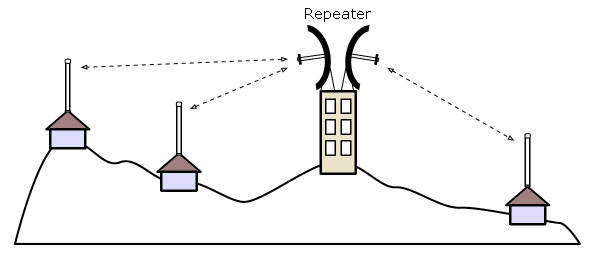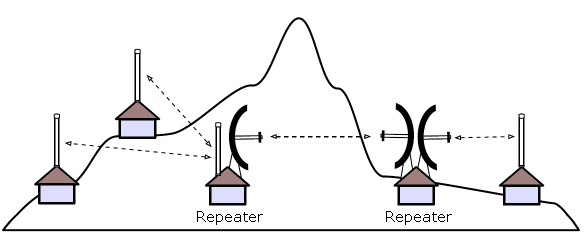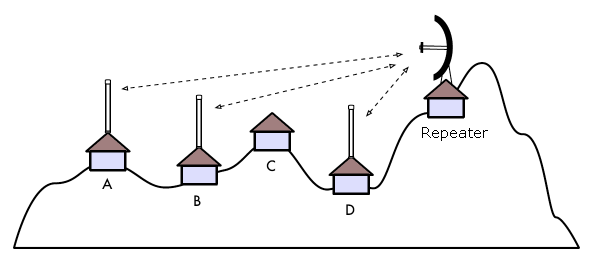| Wireles Networking is a practical guide to planning and building low-cost telecommunications infrastructure. See the editorial for more information.... |

|

Home  Network Design Network Design  Link Planning Link Planning  Repeaters Repeaters |
|||||||
| See also: Line of Sight, Antennas and Transmission Lines | |||||||






|
|||||||
|
RepeatersThe most critical component to building long distance network links is line of sight (often abbreviated as LOS). Terrestrial microwave systems simply cannot tolerate large hills, trees, or other obstacles in the path of a long distance link. You must have a clear idea of the lay of the land between two points before you can determine if a link is even possible. But even if there is a mountain between two points, remember that obstacles can sometimes be turned into assets. Mountains may block your signal, but assuming power can be provided they also make very good repeater sites. Repeaters are nodes that are configured to rebroadcast traffic that is not destined for the node itself. In a mesh network, every node is a repeater. In a traditional infrastructure network, nodes must be configured to pass along traffic to other nodes. A repeater can use one or more wireless devices. When using a single radio (called a one-arm repeater), overall efficiency is slightly less than half of the available bandwidth, since the radio can either send or receive data, but never both at once. These devices are cheaper, simpler, and have lower power requirements. A repeater with two (or more) radio cards can operate all radios at full capacity, as long as they are each configured to use non-overlapping channels. Of course, repeaters can also supply an Ethernet connection to provide local connectivity. Repeaters can be purchased as a complete hardware solution, or easily assembled by connecting two or more wireless nodes together with Ethernet cable. When planning to use a repeater built with 802.11 technology, remember that nodes must be configured for master, managed, or ad-hoc mode. Typically, both radios in a repeater are configured for master mode, to allow multiple clients to connect to either side of the repeater. But depending on your network layout, one or more devices may need to use ad-hoc or even client mode. Typically, repeaters are used to overcome obstacles in the path of a long distance link. For example, there may be buildings in your path, but those buildings contain people. Arrangements can often be worked out with building owners to provide bandwidth in exchange for roof rights and electricity. If the building owner isn't interested, tenants on high floors may be able to be persuaded to install equipment in a window.
If you can't go over or through an obstacle, you can often go around it. Rather than using a direct link, try a multi-hop approach to avoid the obstacle.
Finally, you may need to consider going backwards in order to go forwards. If there is a high site available in a different direction, and that site can see beyond the obstacle, a stable link can be made via an indirect route.
Repeaters in networks remind me of the “six degrees of separation” principle. This idea says that no matter who you are looking for, you need only contact five intermediaries before finding the person. Repeaters in high places can “see” a great deal of intermediaries, and as long as your node is in range of the repeater, you can communicate with any node the repeater can reach.
|
|||||||
Home  Network Design Network Design  Link Planning Link Planning  Repeaters Repeaters |
|||||||
Last Update: 2007-01-24




